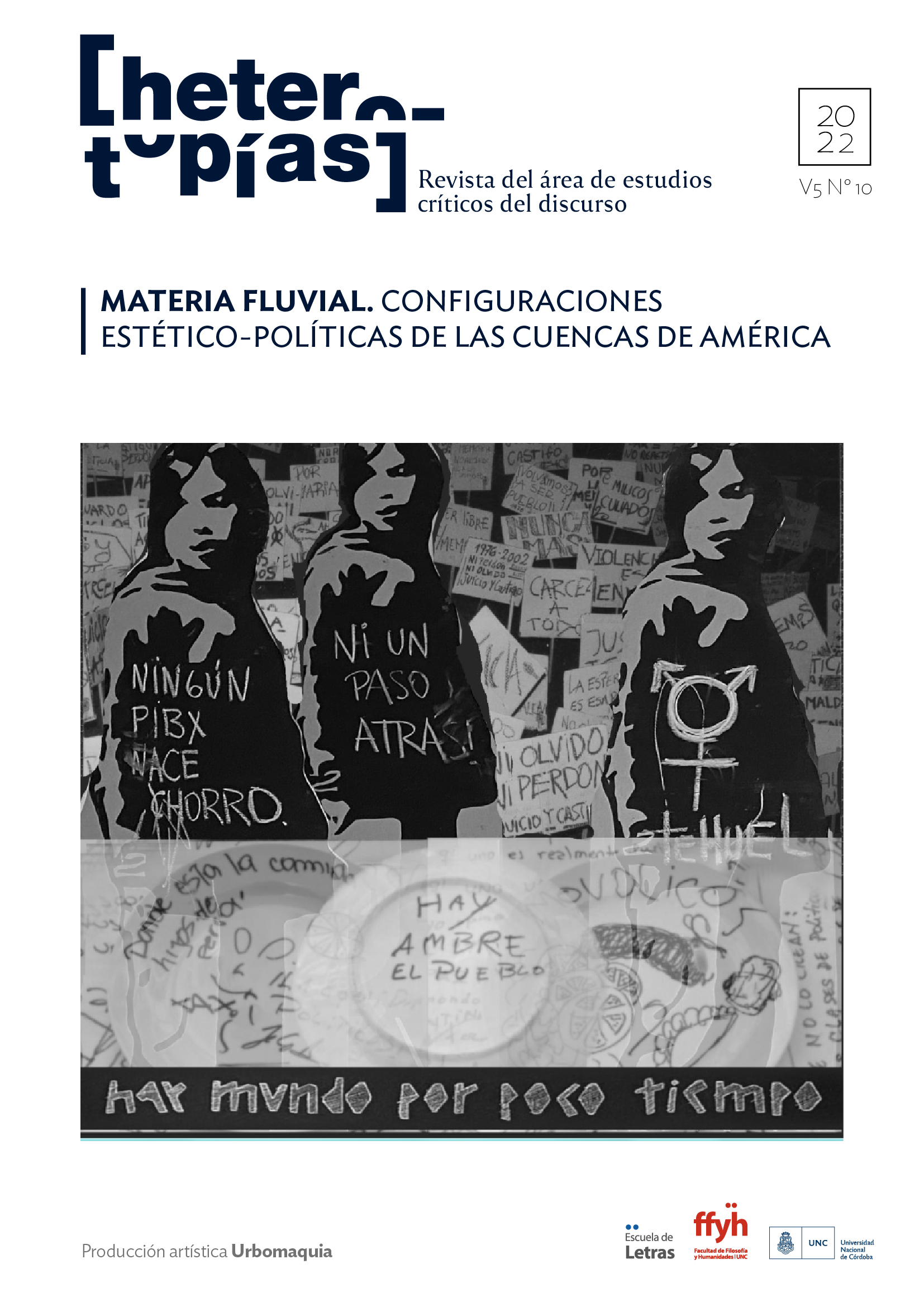Saying the water, saying the river. Notes with archive
Main Article Content
Abstract
This paper looks at some landmarks of the aquatic imagination in Latin America, paying attention to a vibrant matter that promotes assemblages, possible files of temporary superimpositions, sound capsules, time machines, sensitive surfaces, contacts, murmured dialogues, voices and reverberations that encompass us but also exceed us in their transversality. Streams and rivers spin close ties with the coasts they touch, with living beings, with stones and even with those who travel at their expense. From that difficult familiarity arises the judgment of a romantic continuity between the territory of the river and the human presence in the world. Apparently, accidents and nature have always been used as a metaphor for an emotional state. However, there are many indications of the breakdown of that device that thought a continuity between the river and the human world, the mountain and the horizons of the living. At present, the imaginations of water display a non-anthropocentric consideration, imbued with a more radical commitment with the living and with the forces of Gaia, now focused on the continuity between bodies and environment. In its journey, the work spins the rivers of Juan Rulfo with those of Marcelo Brodsky; the mud that drags in the story of Rafael Muñoz with that of Libertad Demitrópulos. Many other rivers end up flowing into the work of Adriana Salazar Todo lo vivo, todo lo muerto: el Lago de Texcoco. As an aquatic territory, lagoons occupy a particular position in the imagination. They are suspicious deposits, more stable than the river, less abysmal than the sea, although they are not excluded for this reason as residences of prehistoric monsters or magical beings.
Downloads
Article Details

This work is licensed under a Creative Commons Attribution-NonCommercial-ShareAlike 4.0 International License.
Those authors who have publications with this journal, accept the following terms: Those authors who have publications with this journal, accept the following terms:
a. The authors will keep their copyright and guarantee to the journal the right of first publication of their work, which will be simultaneously subject to the Creative Commons Attribution - Non-Commercial - Share Alike (by-nc-sa) Attribution License; no commercial use of the original work or any derivative works is allowed, the distribution of which must be done with a license equal to the one that regulates the original work.
b. Authors may adopt other non-exclusive license agreements for the distribution of the published version of the work (e.g., deposit it in an institutional telematic archive or publish it in a monographic volume) provided that the initial publication in this journal is indicated.
c. Authors are allowed and recommended to disseminate their work through the Internet (e.g. in institutional telematic archives or on their website) before and during the submission process, which may lead to interesting exchanges and increase the number of citations of the published work. (See The effect of open access).
How to Cite
References
Andermann, J. (2018). Tierras en Trance. Arte y naturaleza después del paisaje. Santiago de Chile, Chile: Metales pesados.
Bachelard, G. (2000). La poética del espacio. Ciudad de México, México: Fondo de Cultura Económica.
Bachelard, G. (2003). El agua y los sueños. Ciudad de México, México: Fondo de Cultura Económica.
Bartra, R. (2005). La jaula de la melancolía. Identidad y metamorfosis del mexicano. Ciudad de México, México: Randon House Mondadori.
Bennett, J. (2022). Materia vibrante. Una ecología política de las cosas. Buenos Aires, Argentina: Caja negra.
Brodsky, M. (s/f). “Buena memoria: 5. El Río de la Plata”. Recuperado de: https://marcelobrodsky.com/buena-memoria-5-el-rio-de-la-plata/
Demitrópulos, L. (1981). Río de las congojas. Buenos Aires, Argentina: Sudamericana.
Enríquez, M. (2016). Bajo el agua negra. En Las cosas que perdimos en el fuego (pp. 155-174). Barcelona, España: Anagrama.
Gallardo, S. (2000). Eisejuez. Barcelona, España: La Biblioteca Argentina.
Groys, B. (2016). Sobre el activismo en el arte. En Arte en flujo. Ensayos sobre la evanescencia del presente (pp. 55-74). Buenos Aires, Argentina: Caja negra.
Montaldo, G. (2017). Obsolescencia y cultura: la sobrevida de las cosas en la política del tiempo. En Walker, C. (Ed.) Mil hojas. Formas contemporáneas de la literatura (pp. 107-126). Santiago de Chile, Chile: Hueders.
Muñoz, R. F. (2020). Oro, caballo y hombre. En Círculo de Poesía. Revista electrónica de literatura, 12 (20). Recuperado de: https://circulodepoesia.com/2012/08/oro-caballo-y-hombre-cuento-de-rafael-f-munoz/
Ortiz, J. L. (2020). El Gualeguay. En Obra completa (pp. 555-641). Santa Fe, Argentina: Edición UNL.
Padeletti, H. (2007). El andariego. Poemas 1944-1980. Ciudad de México, México: Fondo de Cultura Económica.
Páez, R. H. (1998). “Gualeguay” de Juan L. Ortiz. En Alp: Cuadernos Angers, 2(2), 5-22.
Quiroga, H. (1992) A la deriva. En Cuentos de amor, de locura y de muerte (pp.60-63). Santiago de Chile, Chile: Andrés Bello.
Rulfo, J. (1967). Es que somos muy pobres. En El llano en llamas (pp. 31-36). Ciudad de México, México: Fondo de Cultura Económica.
Salazar, A. (2019). Enciclopedia de cosas vivas y muertas: el lago de Texcoco. Ciudad de México, México: Pitzilein.
Sarmiento, D. F. (2010). El Carapachay. Buenos Aires, Argentina: Eudeba.
Películas
Nueva Argirópolis. Dir. Lucrecia Martel. Argentina, 2010. Cortometraje.
Balnearios. Dir. Mariano Llinás. Argentina, 2002. Documental.
